Pilgrimage to Ireland
I had the incredible opportunity to spend a week touring and learning about the most prominent landmarks of Catholicism in Ireland with fellow pilgrims. We encountered many stories, lessons, and practices that are at the core of Catholic faith, and my hope is to share a few of my learnings below.
First Day: Tour of Dublin
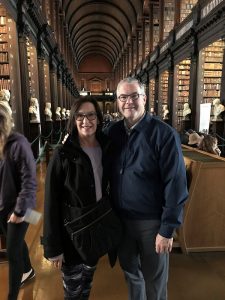
Trinity College with my wife Rita on our first day in Ireland.
Our first day was a long one due to travel from the U.S. We visited Trinity College where we saw the amazing “Book of Kells,” an illuminated manuscript Gospel book in Latin, containing the 4 Gospels of the New Testament: Matthew, Mark, Luke, and John.
It is a masterwork of Western calligraphy and represents the pinnacle of insular art, that is art produced in the post-Roman history of Ireland and Britain. These manuscripts were created around 800 A.D. and are on calfskin. You cannot take a picture of the originals, which are behind thick, dark glass.
After the viewing “The Book of Kells,” we saw the Long Room at Trinity College built between 1712 and 1732 and packed with over 200,000 books of the library’s oldest books. We saw a room which we could not photograph, where there were several people quietly restoring some of these books — certainly a room to visit for Harry Potter fans.
Lastly, a visit to St. Patrick’s Cathedral, the National Cathedral of the Church of Ireland since 1537, but founded in 1191-12 and dedicated to the St. Patrick, the great Catholic missionary and “Apostle of Ireland.”
Interesting fact: Christ Church Cathedral founded in 1030 A.D. is the seat for the Catholic Archbishop of Dublin. The most fascinating thing was hearing about Jonathan Swift. He was the “Dean” for St. Patrick’s from 1713 until his death in 1745. Swift is well-known for his book “Gulliver’s Travels” that he wrote in 1726. Besides being a great author, he was also known for his satire, poetry, and being a strong Irish patriot. Much of his writing reflects his political experiences. He also had a Doctor of Divinity degree and according to our guide could sermonize for as long as four hours.
Garden of Ireland and Glendalough
After a drive through the beautiful mountains of Wicklow, called the “Garden of Ireland,” we arrived in the ancient monastic city of Glendalough. Our guide, Stefan, explained why the street signs were in two languages, English and Gaelic, and the desire by the Irish to maintain a working knowledge of the Gaelic language. Glendalough was established in the sixth century by St. Kevin, and while there are many legends about St. Kevin, he is often compared to St. Francis of Assisi.
Later that day found us at a local restaurant and pub dedicated to many famous Irish literary figures including W. B. Yeats, one of the foremost literary figures in the 20th century. In front of his montage, I am hoisting a “Hop House Lager” beer. Yeats poem, “Long-Legged Fly,” is one of his greatest poems, and it is about silence and how the mind moves upon “silence.” It is about the role silence can play in the fostering of great minds around military tactics, beauty, and artistic creation.
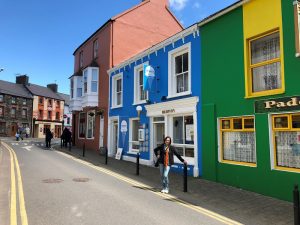
A typical Kilkenny street.
The picture to the left was taken on a typical street in Kilkenny. Because these homes are so uniform in appearance, the different colored doors allow for some distinction. This practice began in Dublin during the Georgian period from the early 18th to the early 19th century.
Interesting fact: In the far distance is the top of the cathedral, St. Canice, of the Church of Ireland built between 1202 and 1285. Catholic in origin, during the English Reformation, it was, by decree, handed over to the Church of Ireland in the late 16th century. There is a round tower from the ninth century that is still accessible by a steep set of internal ladders.
Pentecost Sunday at Rock of Cashel
Our third day fell on Pentecost Sunday. The bulk of the day was spent at the “Rock of Cashel” and ended with Mass at 5 p.m. at the Franciscan Friary in Killarney.
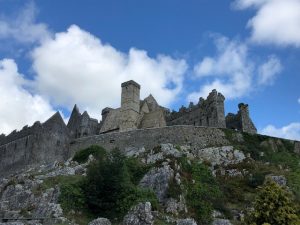
Rock of Cashel
The day finished with my second beer of the trip, a Smithwick’s Red Pale. Just a half pint and so far, of the two beers I have had, the best.
As for the “Rock of Cashel,” I had never heard of it, and quite frankly, we were blown away by what we saw. The religious buildings, dating from the 12th century, form the most spectacular set in Ireland. The site used to be the seat of the High Kings of Munster and is reputed to be the site of the conversion of the King of Munster to Christianity by St. Patrick in the fifth century. The King of Munster donated the site to the Church in 1101 AD. It is picturesque and has one of the most remarkable collections of Celtic art and medieval architecture in all of Europe.
The oldest and tallest of the buildings, the round tower, dates from 1100 A.D. and is 90 feet tall. There are 80 of these round towers in Ireland, and only 13 of them can be accessed. This one cannot. Our guide, David, was incredibly articulate about the history of the site.
Interesting fact: Cormac’s Chapel, the sandstone building, was begun in 1127 A.D. and finished in 1134. It is the very first Romanesque Church in Ireland. Over the years, the sandstone became waterlogged, and the interior frescoes were significantly damaged. A restoration project has completely rain-proofed the chapel, and there are interior dehumidifiers to dry out the stone.
The Cathedral was built between 1235 and 1270 and is an “aisle-less” building in the shape of a cross. In 1647, Cashel was “sacked” by the English, and the Catholic Clergy were all killed, as were the Irish Confederate troops. Among the clergy killed was Fr. Theobald Stapleton who in 1639, published a Catechism in Early Modern Irish to promote the use of the language in religious literature. It was the first noble attempt to simplify Irish spelling to encourage literacy among less educated people.
Dingle Peninsula and Gaelic

My third beer of the trip, a Guinness Stout.
We spent our fourth day in the County Kerry and on the Dingle Peninsula with spectacular views along the West Coast of Ireland. This area has the last part of the country that speaks the Gaelic language, and it is impossible to understand! In one village we visited today, BallyFerriter, about 75 percent of the town’s population speak the Gaelic, or Irish, language daily.
Peig Sayers: A Story of Inspiration
One of the truly inspirational people we heard about today was Peig Sayers who began her career at the age of 12 as a servant for a wealthy family. After a couple of years, she continued to work as a domestic servant for a growing middle-class family. Born in 1873, she was married at age 19 to a fisherman named Pádraig O Guithin and had 11 children of whom, six survived.
Besides being a housewife, she was a prolific author, storyteller, and historian. Though illiterate in the Gaelic language, she knew English, and she dictated her biography to her son Micheal. This bio was published in 1936, and soon after, she dictated 350 ancient legends, ghost stories, folk stories, and religious stories to the Irish Folklore Commission.
Peig Sayers is considered to be among the most famous of a late Gaelic revival genre of personal histories by and about the inhabitants of the Blasket Islands and other remote locations. She depicts the declining years of the traditional way of Gaelic speaking, the poverty that she knew personally, devout Catholicism, folk memories of gang violence, the Great Hunger (1845 to 1849), and the Penal Laws, which forced citizens to accept the Church of Ireland established by the English state Anglican Church.
A Day of Fun and Majesty
There is always a lot to be said about what we are seeing and hearing about in Ireland, but for today, there are only two things to reflect on: fun and majesty.
Joseph Mchugh’s
The fun began at lunch with the fourth beer of the trip, a Rockshore Irish Lager. There is now a tie with this beer and the Smithwick’s Red Ale. Though I only consumed half a pint, with a little help from Rita, it is easy to discriminate from the others. It does turn out that Smithwick’s brewery, founded in Kilkenny in 1710 by John Smithwick, is the most consumed ale in Ireland. The Smithwick family owned the business for 255 years. The brewery was acquired by Guinness in 1965, and The Rockshore was launched in February 2018.
We ate lunch at Joseph McHugh’s, and if you look closely over my left shoulder, you can see a picture of Joe on the wall. Here some lines from a poem about Joseph McHugh himself:
“Come all ye young fellahs, who travel the land,
In search of the crack, with guitar in your hand,
Go down to Liscannor, in the County of Clare,
You’ll find a pub in it that’s ever so rare.
Go into McHugh’s shop, the centre of town; You’ll get a warm welcome from Joe, Chalk it down,
The one-legged canary, will sing How Do You Do,
In the seven-day license of Joseph McHugh.”
Written by Dermott Kelly

Rita and I in front of the Cliffs of Moher.
Cliffs of Moher
As for majesty, the Cliffs of Moher are simply that, majestic. They run for about 14 kilometers and at their southern end they rise about 390 feet above the Atlantic Ocean at a place referred to as Hag’s Head and reach their maximum height of 702 feet just past O’Brien’s Tower. The Cliffs of Moher rank among the most visited tourist spots in Ireland with 1.5 million visitors per year. At peak season, there are an estimated 30,000 pairs of birds living on the cliffs, representing more than 20 species. These include the Atlantic Puffins, the only puffin native to the Atlantic Ocean.
Feast Day of St. Barnabas
Happy Feast Day of St. Barnabas, the “son of encouragement and consolation.”
We started the day off with a visit to Clonmacnoise, considered to be Ireland’s most important monastic site founded by St. Ciaran in the sixth century. It was cold and wet, and the first inclement weather we have encountered that limited our desire to be “out and about.”
Interesting fact: The monastery is on the Shannon River in County Offlay, and it is a beautiful location that became a major center of religion, learning, craftsmanship, and trade by the ninth century. In 1552, the English destroyed and looted Clonmacnoise, leaving it in ruins. One of the first stops by St. John Paul II during his visit to Ireland in 1979 was to the monastery ruins.
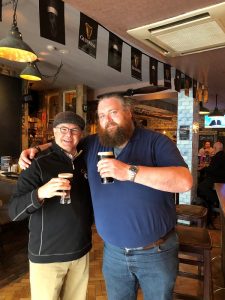
Patrick and I enjoying a White Gypsy Ruby Irish Red Ale.
My fifth beer of the trip was a recommendation from a gentleman by the name of Patrick that we met during lunch. It was an Irish Red Ale called White Gypsy Ruby. I rate it as one of the best I have had so far. I mentioned to Patrick that he was more than big enough to be an NFL football player, and he said he was well off, but thanks anyway!
After lunch, we took a cruise on Corrib Lake, which is the largest lake within the Republic of Ireland and the second largest on the Island of Ireland. It was a great way to see Galway and its surroundings.
We enjoyed dinner and another beer with one of our fellow pilgrims. This time a half pint of Heineken. Jim is an engineer, and his wife is a doctor. They live in Houston, TX, but are originally from Boston. Needless to say, they were rooting for the Boston Bruins in game seven of the Stanley Cup. Did I say Let’s Go Blues!
We visited Galway Cathedral before Mass at St. Mary’s, a Dominican parish. The full name of the Cathedral is the “Cathedral of Our Lady Assumed into Heaven and St. Nicholas. It was completed in 1965 and was built on the site of an old prison.
Since we were on a pilgrimage, I thought I would close by sharing some wisdom gleaned from some reading.
Jesus accepted the reality of human limits out of love for us and obedience to His Father. It only makes sense for us to do the same. “Therefore, I am content with weakness, insults, hardships, persecutions, and constraints, for the sake of Christ; for when I am weak, then I am strong.” 2 Corinthians 12:10.
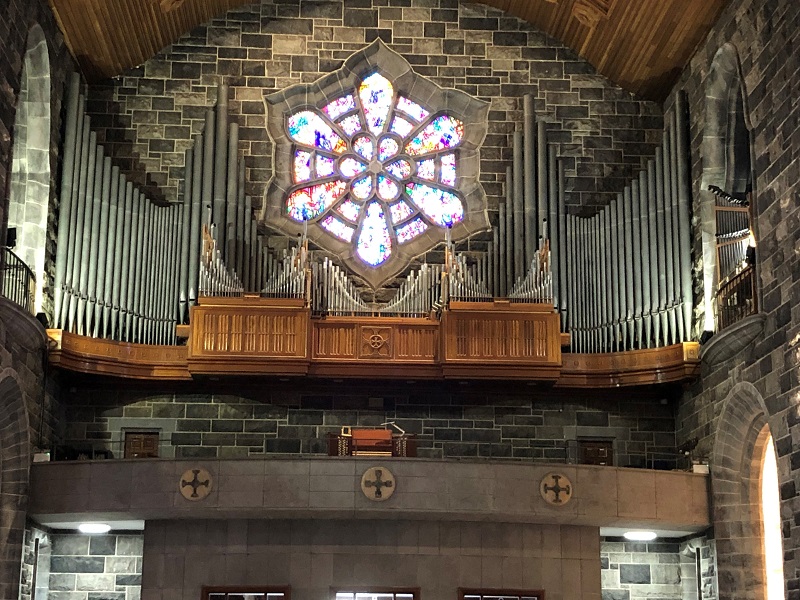
Galway Cathedral